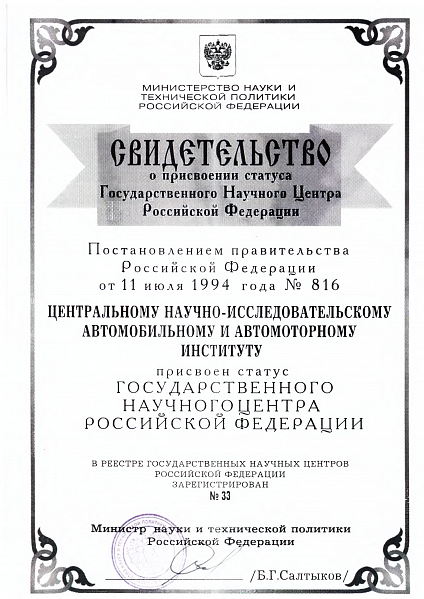25 years ago, the Russian Government issued resolution No 816 dated July 11, 1994 giving FGUP NAMI the status of a state research centre of the Russian Federation for the contribution the organisation had made to the development of the domestic automotive industry.
Since then FSUE NAMI State Research Centre of the Russian Federation has successfully confirmed its high status in all subsequent years. The status of a state research organisation and the state support measures that followed for exploratory research plans and programmes as well as experimental projects allowed FGUM NAMI not only to survive through the trying 1990s and later on, but also to continue to develop its research and development potential and science schools in such fields as:
- sustainability and manageability of automotive vehicles;
- the theory and modelling of automotive engines;
- energy conservation, alternative fuels and environmental safety;
- aerodynamics of motor vehicles and rolling resistance;
- the scientific foundations of bus designs;
- electric vehicles and electric transport;
- noise and vibration in motor vehicles;
- forecasting the strategic development of the automotive industry in the Russian Federation;
- technical regulation, standardisation and certification of motor vehicles, including for such parameters as the design safety of motor vehicles.
The very high level of competencies that FGUP NAMI has achieved today allows it to carry out research and development projects many of which go through all the implementation stages in the institute, from the initial ideals through design to complete manufacturing cycles. In addition, FGUP NAMI can now offer research, development, engineering and production services, including design, development of smart management and control systems, development of software, digital design and prototyping services, manufacture of limited industrial batches of industrial machines for various industries. The human resources, the vast and varied experience and the technology potential have ensured implementation of advanced projects that have received important state awards. These included the design and development of the Ural family of all terrain vehicles (the NAMI-020 prototype, the development of the V6 and V8 NAMI 019 diesel engines that eventually went into mass production under the brands of YAMZ-236 and YAMZ-238
From the history of NAMI, 1994.
In 1994 the NAMI institute was already regarded as one of the most advanced companies in the country and in cooperation with other companies, research institutions and organisations it was already acting as a research and development centre with unique experimental equipment and highly skilled staff, demonstrating consistently outstanding results in fundamental and exploratory research.

In 1994 the research institute designed a high capacity urban bus called Progress, designed diesel-CNG engines and motor vehicles and organised mass production of both at KAMAZ. On the order of the Moscow Government a family of CNG buses and engines were designed for the state-owned transport company Mosgortrans as well as a family of minibuses based on the Bychok vehicle that ran on environmentally friendly dimethyl ether. Using its own research laboratories and production equipment NAMI designed and manufactured industrial batches of exhaust fume neutralisers and installed them on practically all the buses of Moscow bus fleets. FGUP NAMI designed a series of diesel engines and environmentally friendly gasoline engines featuring the traditional layout, which were then mass produced by the country's automotive companies. Prototype vehicles running on hydrogen fuel were built as well as experimental axial engines with variable displacement and compression ratio. A multifunctional all-wheel-drive vehicle with a capacity of 0.5 tonnes and a set of removable equipment of various types was developed for housing utilities and farmers. The achievements of NAMI in the development of the Russian automotive industry, its efforts aimed at standardisation and regulation of various aspects of the automotive industry were already recognised at the international level then as well.

